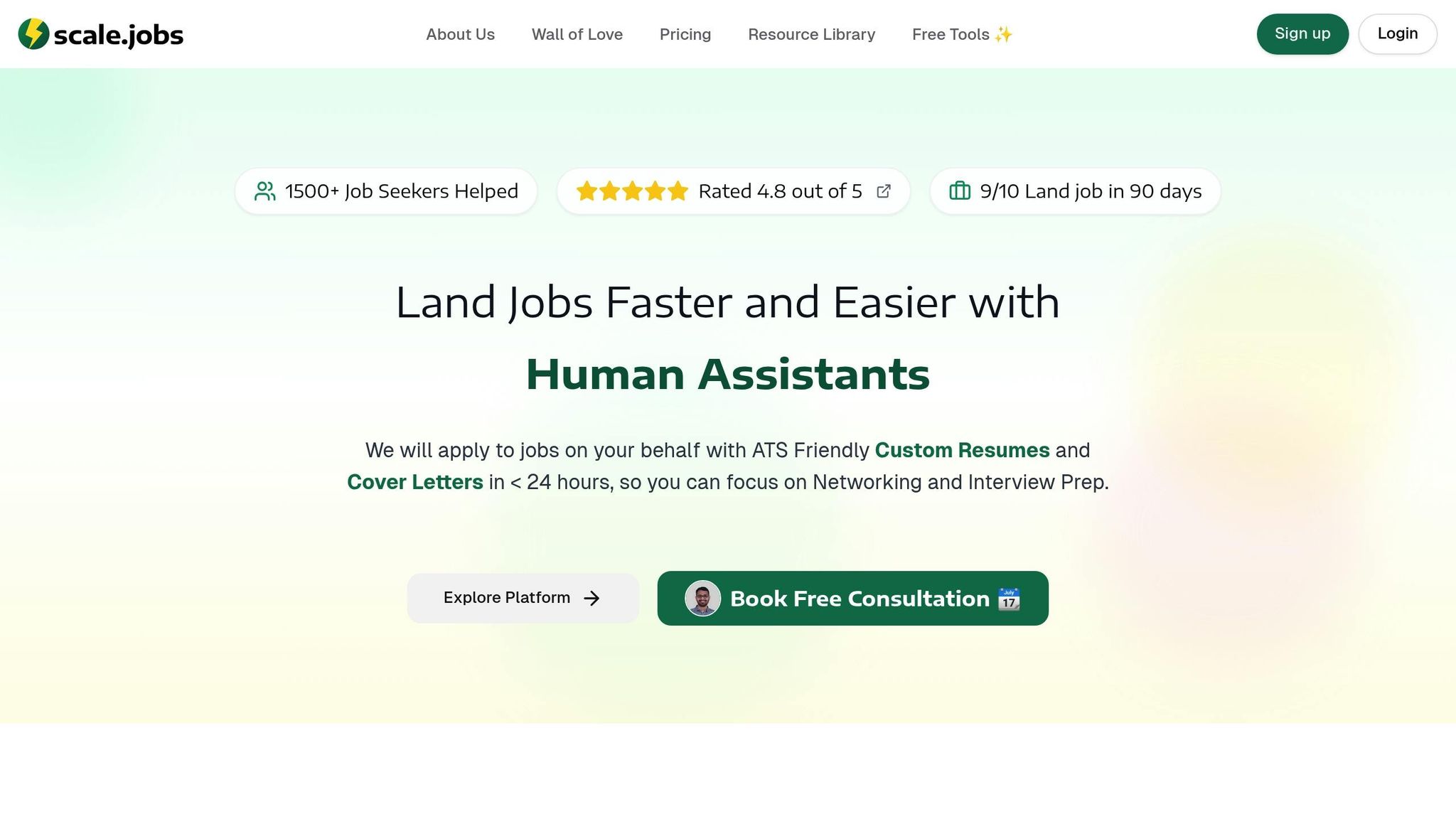Portfolio Content for Tech Jobs: What Recruiters Want
Learn how to create a tech portfolio that impresses recruiters by showcasing problem-solving skills, project variety, and effective communication.

Your tech portfolio is your proof of skills and often your first impression with recruiters. With 80% of recruiters spending under three minutes reviewing portfolios and 7.7 million job openings as of January 2025, you need to stand out fast. Here’s what recruiters prioritize:
- Problem-solving skills: 85% of hiring managers value this above all else.
- Project variety: 70% want to see diverse projects showing your range.
- Soft skills: 60% look for teamwork and communication, especially for international candidates.
Your portfolio must showcase measurable impact, clean and professional code, and clear project narratives. It should also be mobile-friendly and easy to navigate, with live demos or visuals that make your work accessible. Avoid common mistakes like broken links, outdated projects, or overly generic content.
Key takeaways for a standout portfolio:
- Include 4–10 high-impact projects using modern tools like React, Python, or Vue.js.
- Focus on case studies that outline challenges, solutions, and results.
- Use interactive demos, clean documentation, and visuals to highlight your work.
- Tailor your portfolio to the job you’re targeting, whether it’s frontend, backend, or data science.
Platforms like scale.jobs offer human-powered assistance to optimize your portfolio and applications, ensuring you connect with recruiters effectively.
What Recruiters Want in Junior Developer Portfolios
What Recruiters Look for in Tech Portfolios
Creating a tech portfolio that grabs a recruiter's attention requires a mix of strong technical skills, impactful projects, and clear communication. While recruiters share some general expectations across tech roles, each discipline has its own unique requirements. By understanding these specifics, you can craft a portfolio that stands out and gets noticed.
Projects with Measurable Impact
More than 60% of recruiters prioritize projects that address real-world challenges. Your portfolio should showcase your ability to tackle practical problems and deliver effective solutions. For frontend roles, highlight visually impressive and engaging projects. Backend developers should focus on systems capable of managing heavy user loads efficiently.
In data science, portfolios shine when they include projects that demonstrate both technical skills and problem-solving creativity. Examples could range from cleaning messy datasets to crafting compelling data stories. Product managers should use their portfolios to present the reasoning behind their product decisions, detailing the obstacles faced and the tradeoffs made along the way. UX/UI designers, on the other hand, should highlight projects that clearly show improvements in usability and aesthetics, with before-and-after comparisons.
While impactful projects are key, recruiters also look for evidence of strong technical skills, which we’ll explore next.
Technical Skills with Proof
A whopping 80% of top employers want to see clean, well-documented code. This means your repositories should be well-organized, include clear README files, and reflect professional coding standards. Recruiters are looking for evidence that you can produce maintainable, high-quality work.
Make sure to feature projects that use modern frameworks like React or Vue.js and tools relevant to your field. Link to your repositories (e.g., GitHub) and include visual elements like screenshots or interactive demos. Live demos are especially effective, as they allow recruiters to experience your work directly. For data science roles, showcase projects that walk through your entire analytical process, from cleaning raw data to delivering actionable insights. Product management portfolios should clearly outline challenges, decision-making processes, and measurable outcomes. For UX/UI designers, high-quality prototypes and mockups that demonstrate both design skills and user-focused thinking are essential.
Soft Skills Through Project Stories
Recruiters also value the human side of your work, which should be reflected in your project narratives. Instead of listing soft skills, use your portfolio to tell the story behind each project. Explain the challenges you faced, the approach you took, and the results you achieved. Use numbers to quantify your impact - like reducing onboarding time or increasing user engagement. If you worked on a team, make sure to clarify your individual contributions.
Clean Design and Easy Access
How your portfolio looks and functions is just as important as what it contains. About 70% of hiring managers want to see a variety of projects, but they also expect a portfolio that's easy to navigate. Ensure your portfolio is mobile-friendly and free of broken links. Keep it up to date with your latest and most relevant work - outdated projects can leave a bad impression.
For UX/UI designers, your portfolio's navigation and design should serve as a testament to your skills. A well-structured, visually appealing portfolio not only grabs attention but also demonstrates your understanding of good user experience principles.
Ultimately, the best portfolio projects are those that are engaging, technically relevant, and easy to explain. They should reflect your ability to solve real problems and effectively communicate your process.
How to Choose and Present Your Portfolio Content
When building your portfolio, focus on showcasing high-quality projects that clearly demonstrate your skills. The goal is to strike a balance between variety and depth while ensuring every project tells a clear story about what you bring to the table.
Must-Have Content Types
- Case studies: Break down projects into sections like the problem, solution, implementation, and measurable results. This format highlights your problem-solving approach and the specific contributions you made.
- Open-source contributions: Show your ability to collaborate and work with existing codebases. Link to your GitHub repositories with clean, well-documented code. Make sure your README files are detailed, explaining what the project does, how to set it up, and the technologies used.
- Interactive demos: Let recruiters experience your work firsthand. These are especially valuable for frontend developers and UX/UI designers.
- Technical documentation and code samples: Share examples of maintainable, professional-quality code. Include snippets that show your coding style and how you solve complex problems. For data scientists, Jupyter notebooks that outline your analytical process can be a great addition.
- Testimonials and references: Add credibility with quotes from colleagues, managers, or clients who can vouch for your skills and work ethic. These insights help recruiters see how you collaborate and contribute to team success.
Once you've identified the content types you'll include, it's time to carefully select and organize your portfolio.
Step-by-Step Content Selection
Audit and rank your projects based on impact and relevance. Choose projects that demonstrate measurable results. Even if the outcomes aren't massive, focus on improvements like better efficiency, enhanced user experience, or optimized system performance.
Include 4–10 diverse projects that showcase your versatility and familiarity with modern frameworks. For example, highlight work with React, Vue.js, Node.js, or Python. Full-stack developers should feature a mix of frontend, backend, and full-stack applications. If you're a data scientist, include projects that span the data pipeline, from cleaning datasets to building predictive models.
Prioritize projects that reflect current technologies and skills. Recruiters want to see that you're keeping up with industry trends. Skip outdated projects unless they demonstrate exceptional problem-solving.
Feature both solo and team projects. Passion projects highlight your technical interests, while professional work shows your ability to deliver in business settings.
Tailor your portfolio to the job you're targeting. For frontend roles, emphasize visually engaging projects with interactive elements. Backend developers should focus on system architecture, database design, or API work. Product managers can showcase projects involving strategic planning and cross-functional collaboration.
Keep your portfolio up-to-date. Regularly remove older projects that no longer reflect your abilities and add new ones that demonstrate your growth. For each project, include a brief description of your role and contributions, especially for team efforts.
Balance technical detail with clarity. Make sure both technical and non-technical reviewers can easily understand your work. This approach ensures your portfolio effectively highlights your skills and leaves a strong impression on recruiters.
Common Portfolio Mistakes to Avoid
Building a strong portfolio is only half the battle. To truly make an impression, you need to steer clear of common mistakes that can overshadow your skills and professionalism. Even the most talented tech professionals can hurt their chances with errors that suggest carelessness or outdated knowledge. Here’s what to watch out for:
Outdated or Broken Projects
Few things damage your credibility faster than broken links or outdated projects. Imagine a recruiter clicking on a demo link, only to hit a 404 error or see a project built with technologies no longer in use. It immediately casts doubt on your attention to detail and whether your skills are up to date.
"Keep your portfolio up to date and make sure everything is working smoothly to provide a seamless user experience." - MoldStud Research Team
"Since a LinkedIn profile is sometimes the recruiter's only source of information about a candidate, the more detail they provide in the Experience section, the better because it makes it easier to determine their suitability for the role at a glance. If the recruiter can't easily see what they're looking for, they might move on to other candidates." - Stacey Mallory, Managing Director at Altis Recruitment
If your deployed project is no longer live, replace broken links with high-quality screenshots and detailed descriptions. Include images that highlight the interface and functionality, and add a thorough README file explaining the project’s purpose, technologies used, and challenges tackled.
Make it a habit to review your portfolio regularly. Remove outdated work that no longer reflects current industry trends and focus on showcasing projects that highlight your most relevant skills. Beyond technical errors, avoid overwhelming recruiters with overly wordy content that buries the important details.
Generic or Text-Heavy Content
Recruiters don’t have time to sift through dense paragraphs or vague project descriptions. If your portfolio doesn’t quickly communicate your value, it risks being overlooked.
Avoid writing generic descriptions like, "Built a web application using React and Node.js." Instead, get specific about your contributions and the impact of your work. Here’s how to make your portfolio more engaging:
- Break up text into scannable bullet points.
- Use bold headings like "Problem Solved", "Technologies Used", and "Results Achieved."
- Highlight measurable results and the problems you solved upfront.
- Include visuals such as architecture diagrams, before-and-after screenshots, or data visualizations to tell the story of your work.
Interactive demos and visual proof are far more compelling than lengthy technical explanations. Keep your writing concise and ensure your portfolio format works seamlessly across all devices.
Poor Mobile Experience and Accessibility
With recruiters often reviewing portfolios on their phones, a portfolio that isn’t mobile-friendly can cost you opportunities. A clunky mobile experience or inaccessible design sends the wrong message about your skills.
Here’s a quick mobile optimization checklist:
- Test your portfolio on various devices and screen sizes.
- Compress images and streamline your code to ensure fast loading times.
- Make sure touch interactions are smooth and intuitive.
- Use proper heading hierarchies, sufficient color contrast, and alt text for images.
- Incorporate ample white space and clear, readable typography.
Accessibility matters, too. Designing with accessibility in mind not only makes your portfolio usable for everyone but also demonstrates your commitment to inclusive design principles.
Ultimately, your portfolio should offer a smooth, frustration-free experience that lets recruiters focus on your work - not struggle with the interface.
scale.jobs vs Competitors for Portfolio Development

Once you’ve polished your portfolio, the next big challenge is getting it in front of the right people. A well-crafted portfolio demonstrates your technical skills, but without a strategic approach to job searching, it may never reach the recruiters who matter. Many tech professionals spend weeks perfecting their portfolios, only to have their applications stuck in automated systems. This is where choosing the right platform can make all the difference. Let’s take a closer look at how scale.jobs stacks up against its competitors and why its human-focused strategy delivers better results.
Why scale.jobs Stands Out
Platforms like TealHQ and LazyApply rely heavily on automation, which often overlooks the subtle details that make a portfolio shine. In contrast, scale.jobs focuses on human-powered assistance, transforming generic applications into personalized, standout submissions that align with specific job requirements.
With scale.jobs, expert virtual assistants ensure your portfolio gets the attention it deserves. They tailor each application, crafting custom cover letters that directly connect your best projects to the job at hand. This personalized approach ensures your work doesn’t just pass through applicant tracking systems (ATS) - it stands out to recruiters.
The pricing model is another key advantage. Unlike TealHQ's weekly subscription fee of $9, scale.jobs offers a one-time payment starting at $199 for 250 applications. This flat-fee structure provides transparency and peace of mind, allowing you to focus on landing interviews instead of managing ongoing costs. Plus, with WhatsApp support, you receive real-time updates and adjustments to emphasize your key projects. To top it off, proof-of-work transparency - via timestamped screenshots - lets you see exactly how your portfolio is being presented to employers.
What makes scale.jobs different?
- Human-powered support for tailored, ATS-optimized resumes and cover letters.
- Transparent pricing with a one-time payment starting at $199, avoiding recurring fees.
- Real-time communication through WhatsApp for instant updates and adjustments.
- Proof-of-work transparency with timestamped screenshots for every application.
The results speak volumes. For instance, Apoorv Singh, facing a layoff with just 60 days left on an H1B visa, secured three job offers and a 75% salary increase after using scale.jobs[1].
Feature Comparison Table
| Feature | LazyApply | TealHQ | TopResume | scale.jobs |
|---|---|---|---|---|
| Application Method | AI automation | AI-powered templates | Resume writing | Human assistants |
| Pricing Model | $99–$999/year | $9/week subscription | $149–$699 | $199–$1,099 one-time |
| Portfolio Integration | Template-based | Automated optimization | Single rewrite | Custom per job |
| Support Type | Email templates | |||
| Success Tracking | Basic analytics | Application count | Interview guarantee | Proof-of-work screenshots |
| ATS Optimization | Keyword matching | Automated matching | Professional review | Expert human optimization |
Unlike purely AI-driven tools like Rezi.ai or ResumeGenius, scale.jobs assistants understand the specific demands of tech roles. Whether your portfolio highlights full-stack development for startups or system architecture for enterprises, these human specialists know how to position your work to resonate with employers.
Clients of scale.jobs consistently report interview rates that exceed industry averages. By crafting applications that authentically connect your portfolio to employer needs, the platform ensures your technical projects don’t get lost in the crowd of automated submissions. This personalized approach makes all the difference in showcasing your work effectively.
On top of that, scale.jobs provides free resources like a Portfolio Website Generator and an ATS Resume Checker. These tools help refine your presentation, ensuring your portfolio is as strong as possible before you start applying. This well-rounded strategy ensures your portfolio gets the attention it deserves and opens doors to the right opportunities.
[1] Scale.jobs blog, May 22, 2025
Building a Portfolio That Gets Results
To make a lasting impression in the tech world, your portfolio needs to align with what recruiters are looking for. Studies show that a well-crafted portfolio can significantly improve your chances of landing a job.
Start by selecting 4–10 projects that highlight your ability to solve real-world problems and work effectively in teams. Each project should tell a story - how you tackled challenges, the technologies you used, and the results you achieved. Focus on measurable outcomes, as they make your contributions more memorable.
Presentation matters just as much as content. Your portfolio should be visually appealing, easy to navigate, and mobile-friendly. Include screenshots, animated GIFs, links to live demos, or GitHub repositories to provide detailed insights into your work. Make sure it loads quickly and functions seamlessly on mobile devices - first impressions count.
Customizing your portfolio for the specific role you’re targeting can give you a competitive edge. Take inspiration from full-stack developer Jacek Tomaszewski, who uses clear calls to action and a timeline view that naturally leads to an availability statement. This kind of tailoring shows recruiters that you’re not just showcasing skills - you’re demonstrating how they fit the job at hand.
But building a great portfolio is only half the battle. How you deliver it is just as important. While many platforms rely on automation, scale.jobs takes a human-centered approach to ensure your work stands out. They create personalized cover letters that connect your best projects to specific job requirements, giving your portfolio the attention it deserves.
To further refine your presentation, tools like the Portfolio Website Generator and ATS Resume Checker help ensure every detail meets recruiter expectations. With transparent pricing starting at $199 for 250 applications and real-time WhatsApp updates, you can focus on interview prep while leaving the delivery strategy to the experts.
Your portfolio, built on years of effort, becomes a game-changing tool when paired with a smart, targeted delivery approach.
FAQs
How can I showcase my problem-solving skills in a tech portfolio effectively?
Showcasing Your Problem-Solving Skills
When highlighting your projects, focus on those where you tackled tough challenges and break down your problem-solving process step-by-step. Clearly explain how you approached the issue, the strategies you applied, and the results you achieved. Whenever possible, include measurable outcomes - like increased efficiency, improved performance, or reduced costs - to emphasize the real-world impact of your work.
For example, you could feature projects such as:
- Open-source contributions: Share how you identified gaps in existing tools or frameworks, collaborated with others, and delivered solutions that benefited the community.
- Hackathon achievements: Highlight how you worked under tight deadlines, brainstormed creative ideas, and developed a functional prototype to solve a specific problem.
- Real-world case studies: Detail how you addressed a complex issue in a professional or academic setting, outlining both the challenges and the innovative techniques you used to overcome them.
Don’t forget to showcase team collaborations - emphasize how you worked with others, divided responsibilities, and combined efforts to achieve success. This not only shows your technical skills but also your ability to work effectively in a group setting. Use clear and concise descriptions to make your portfolio stand out and grab the attention of recruiters.
What makes a tech portfolio user-friendly and optimized for mobile devices?
Creating a tech portfolio that works well on mobile devices means focusing on a responsive design that adjusts smoothly across various screen sizes. Incorporate touch-friendly features like larger, easy-to-tap buttons, and make sure pages load quickly by optimizing images and streamlining your code. Stick to a clean design with readable fonts, proper spacing, and a straightforward layout that helps users find essential sections effortlessly. Prioritizing accessibility and ease of use will ensure your portfolio stands out to recruiters.
How does scale.jobs' human-powered service make my tech portfolio more effective than automated tools?
Scale.jobs offers a hands-on service to ensure your tech portfolio catches the eye of recruiters. With the help of trained virtual assistants, they craft customized, ATS-friendly portfolios that spotlight your skills and accomplishments, giving you an edge in today’s competitive job market.
What sets this service apart from automated tools is its human touch. You’ll receive real-time updates via WhatsApp, complete proof-of-work transparency, and tailored content designed to meet recruiter expectations. This personalized approach ensures your portfolio is polished and impactful, boosting your chances of securing interviews and job offers.


![[UPDATED-2026] Job Search Strategies That Actually Work: Tips + Best Tools](/content/images/size/w600/2025/12/image-1764688576191.jpeg)

